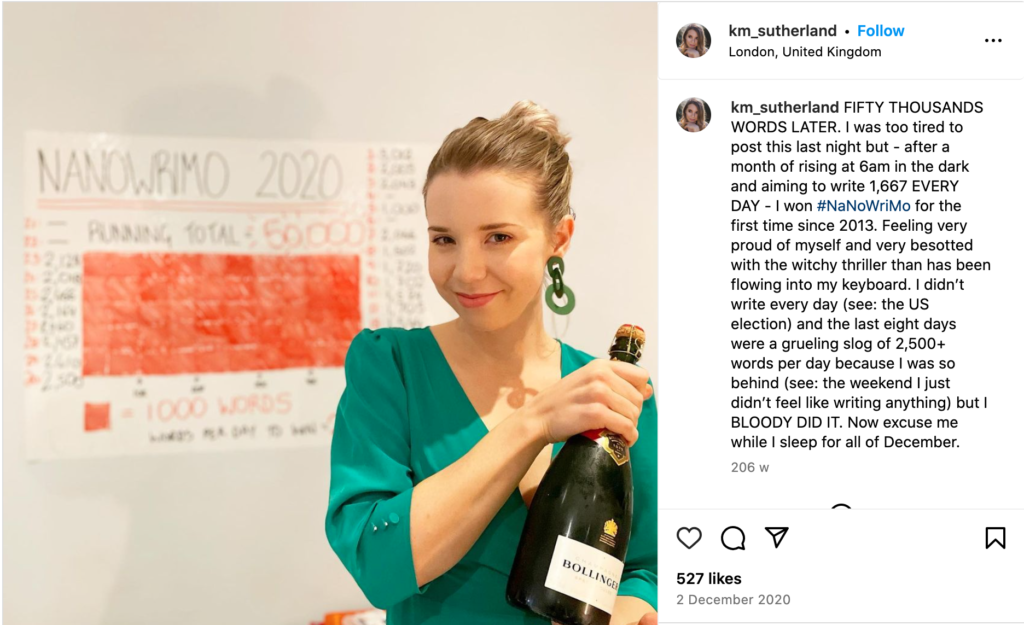National Novel Writing Month (or NaNoWriMo) is a one-way ticket for writers to enter four weeks of self-inflicted madness (or so many authors have said), and write in any spare moment they can. The need for a rush of words leaves little time to overthink, go back or delete (as writers otherwise often would, in a cloud of self-doubt). Signing up will turn one into a “Wrimo”: a writer who must type something every day, whether it be five words or five thousand, and always adding to one’s manuscript, whether it be editing a novel, or starting completely fresh on a blank page.
The aim of NaNoWriMo is simple: to write 50,000 words between November 1st to the 30th.
To participate, creative writers (who must be over thirteen years of age), sign up to the NaNoWriMo website – a nonprofit group – and create a profile (free of charge) and, every day, as they add prose, they will see their word count climb toward that finish line.

(NaNoWriMo is between November 1st to the 30th | Credit: Daniel Schludi | Unsplash)
The perks of being a “wrimo”
A writer could add words to their story anytime, in any month – so why November? Why sign up for NaNoWriMo?
The answer: because writers are essentially signing a contract with themselves, a blood oath inked in Times New Roman font; a promise that, by the end of the four weeks, they would have written 50,000 words (or as close to).
They are also trying to vanquish the demons that sit on every writer’s shoulder when at their desk and staring at their computer screen: writer’s block and self-doubt. For in a sense, writers are bird watchers, except instead of eyeing the sky, they are focused on the endless pages filled with their prose, all too eager to find an error, something that tells them their manuscript makes no sense, and they would do better to return to their cave – let only the real eagles, the published, successful writers be authors. But that is when November saves the day, and the benefit of NaNoWriMo comes into play. For on the NaNoWriMo’s home site, one of their tips for conquering the 50,000-word challenge is, “Always move forward”.
“Never go back and edit your first draft while you are writing it. Always move forward”, said the late author and screenwriter, Colin Butts, and this can easily be accomplished for wrimos, due to the fast pace of NaNoWriMo, which they must try to adhere to, to win it.

(There are many strategies that writers adopt when it comes to NaNoWriMo | Credit: Patrick Tomasso | Unsplash)
Proof that participation, with the right plan, can lead to success:
NaNoWriMo was founded in 1999, and then only consisted of 21 participants; in 2021, that number has grown past 427, 653 wrimos, and through the years there have been countless strategies on how best to tackle the word count. Currently, there is one strategy that is most popular:
Per day: 1, 667 words.
Per week: 11, 669.
The theory was that if wrimos stuck to the plan, they would accumulate 50,000 words by the end of the month. However, there is no set number when it comes to daily word count, and it’s important to remember that every writer must do what works best for them and their own schedule.
There’s an abundance of proof it can be done, though. There are countless published, popular novels that were worked on during NaNoWriMo, often surprising some readers, such as: Rainbow Rowell’s Fangirl, Sara Gruen’s Water for Elephants, Hugh Howey’s Wool, The Night Circus by Erin Morgenstern, and Aussie author Krystal Sutherland – who was a wrimo in 2020 – used it to help pen her most recent novel, The Invocations, as well as many more writers whose novels were written in November.

Krystal Sutherland’s Instagram post after completing NaNoWriMo 2020
(Credit: Krystal Sutherland | Instagram)
If NaNoWriMo isn’t someone’s cup of tea, however, it’s important to remember that there are many different word counts for books and different ways to get stories ready and words onto the page, and then out into the world:
- Apply to writing competitions: There will be several writing competitions happening in 2025.
2. Post prose on social media: the publishing platforms, Medium and Substack, allow for a wide variety of fiction and non-fiction, such as articles, opinion pieces, movie reviews and blogs (as well as much more) and short stories and novels.
For creative writers, it’s imperative to understand that there’s no right or wrong way when it comes to writing a story and, if a certain time of year works better, then any month can be your Novel Writing Month. Any season can be your damn season. Writers, now write it down…



